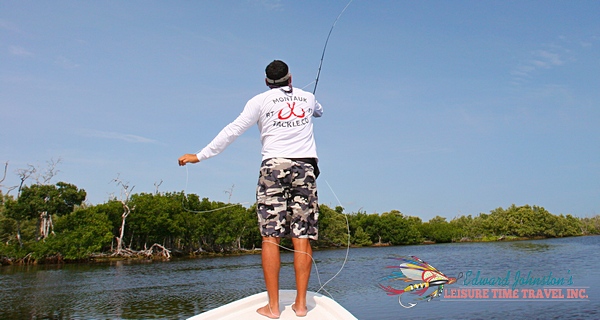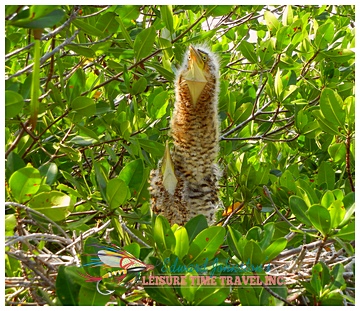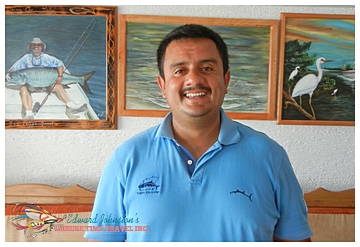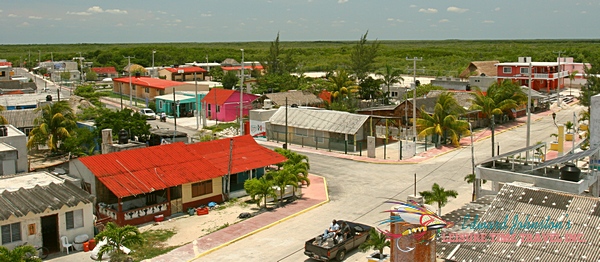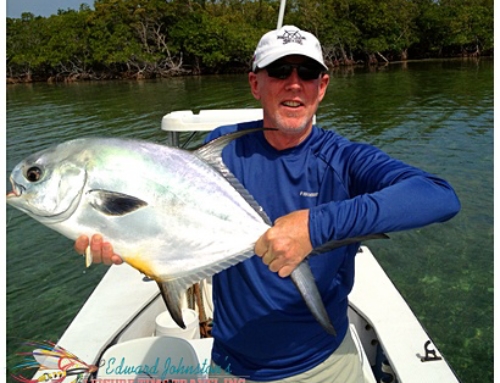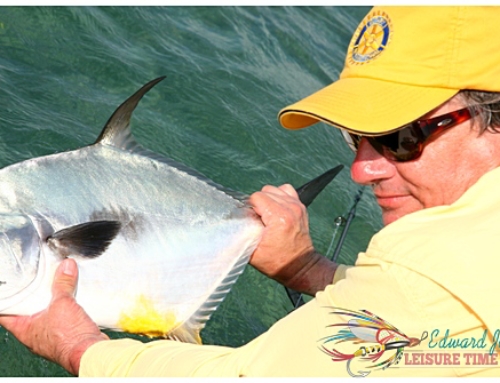Editors note: Since this post was written Tarpon Cay Lodge has moved its operation to the nearby town of Los Lagartos. Click here to go to that page.
This is our latest onsite report for Tarpon Cay Lodge which is located in a very remote region of northern Mexico’s Yucatan peninsula. To see the full cycle of a tarpon’s life, from baby tarpon found in the back creeks and ponds, to the juveniles in the mangrove estuaries, and the larger fish near the Gulf is a unique opportunity for any dedicated angler. If you are interested in tarpon fishing at Tarpon Cay Lodge in the Yucatan peninsula between Parque Natural San Felipe and Rio Lagartos Estuary – read on!
I am relaxing on the upper balcony of the four-story Hotel San Felipe admiring the view of this Yucatan fishing harbor and Gulf of Mexico. A cool sea breeze and the sound of the sea create a tranquil sensation in this paradise. Soon, I will be making the drive to the western side of the Yucatan peninsula near Campeche and indulge in the fishing there.
It is difficult to leave this picturesque place. Amazing beautiful, is still isolated from the rest of the modern world. San Felipe is a small port town located on the northern Yucatan’s mangrove coast and is accessible only by long winding roads through the Yucatan countryside.
The unique topography of the northern Yucatan peninsula is low-lying and almost flat land with a thin crust of soil. The jagged porous lime rock base protrudes everywhere.
If you look at a map of the Yucatan showing surface features such as rivers, ponds, hills and valleys, you’ll notice that the northern peninsula’s has no inland rivers at all, but it does have many sinkholes, called cenotes. In The Yucatan, underground water drains relentlessly in underground caverns dissolved by rainwater, from the inland region toward the coasts. This water originates far away in the Peninsula’s interior and creates a unique ecosystem. There are thousands of cenotes in the northern Yucatan. Inland the cenotes may create a spring-fed pond, lake or swamp. When the freshwater sinkholes are located near shore, or off the coastline, the local people call them “ojo de agua”, or eye of the water. I call them fish magnets which create a center of attraction for various species and you will find them here.
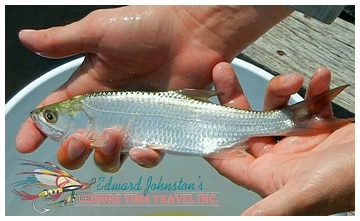
There are countless little tarpon like this in the low areas surrounding San Felipe. Friends gather these little guys up during the dry season and place them safely in the mangroves.
If you have fished Ascension Bay or Espiritu Santo Bay you know what I am talking about, as there are dozens of fresh water sinkholes in the back bays (there are also saltwater tidal “blow holes”, but we will talk about that another time).
The fishery in this region offers incredible opportunities. This is tarpon country and they come in all sizes here. From itty-bitty babies to juveniles to giants, they all live here in the estuaries of the mangrove lined lagoons, clear turtle grass flats near shore and mysterious deep water places offshore. To see the full cycle of a tarpon’s life, from babies found in the back creeks and ponds, to the juveniles in the mangrove estuaries, and the larger fish near the Gulf is a unique opportunity for any dedicated angler.
San Felipe is straddled by two of the most beautiful Biosphere Reserves in the world, Parque Natural San Felipe which extends more than 20 miles to the west and Rio Lagartos Estuary which extends more than 30 miles to the east. The reserves have similar eco-regions; clear turtle grass flats transitioning to mangrove lined lagoons and coastal wetlands, and dry upland forests.
You will find the four major Caribbean mangroves species here. Near shore the water has a slight tannin stain which is derived from decaying mangrove stems and leaves. Mangroves are vital to the whole inshore ecological community as they provide habitat and shelter to many species from the bottom of the food chain to the top.
The mangrove estuaries are loaded with baby and juvenile tarpon. This region is also home hundreds bird species including Flamingos, Roseate Spoonbill, Osprey, Pelicans, Frigates, Gulls, Egrets, Grackle, and Chachalaca. You may also encounter White-tail Deer, the elusive Jaguar, Margay, Coati, Gray Fox, and numerous other Yucatan mammals. And, there are many reptiles here including various turtles, Iguanas and a small population of crocodiles.
The fishing program for Tarpon Cay Lodge centers on the Hotel San Felipe which is situated harbor side in the center of this small fishing village. The hotel is not fancy, but it is clean, comfortable and well appointed. The air-conditioned rooms are more than adequate for two guests with two double beds, and private bath with shower.
Your host at the Hotel is Veto or “Bee-tow” for English speakers. With any new experience there is a feeling of unfamiliarity and uncertainty. Veto will immediately put you at ease and make you feel like you are with friends and family. You can travel here by yourself and never feel alone. I asked Veto where he learned English. Veto told me he watched a lot of American movies, especially Arnold Schwarzenegger Terminator movies. “Hasta la vista, baby” he quoted!
Veto’s main duty at the Hotel is chief chef, but he also joins in at bartending and serving. During Veto’s off time he is delighted to show you around the town and country side. Veto make take you to a cenote to fish for mojarra, a sightseeing trip to Rio Lagartos Estuary, let you lend a hand rescuing stranded baby tarpon, or take you to a bull fight, which is quite a cultural event in the Yucatan.
Tarpon Cay Lodge’s peak season is May through August. The weather is calm and the tarpon are usually plentiful. Tarpon Cay Lodge, like its sister Lodge, Isla del Sabalo, is a fly fishing lodge developed for one purpose and that is fishing for tarpon and offers some of the best tarpon angling available today. These fish are largely undisturbed and will respond to most well-presented flies. There are other fish available here including jacks, snappers, barracudas, spotted sea trout and snook, however consider those as a bonus species.
The fertile waters of Mexico’s northern Yucatan Peninsula represent one of the most productive juvenile tarpon fisheries in the world. Tarpon Cay Lodge is relatively inexpensive, easy to get to, and very compatible to light tackle and fly fishing.
For a remote destination experience offering a pure unspoiled tarpon fishery, look no further than Tarpon Cay Lodge. The clear grass flats and backcountry lagoons provide extraordinary fishing opportunities.
The rate for a 7 Night / 6 Day combo package is $3,965 per angler (double occupancy). This will include all transfers in a new air-conditioned Chevy Express Super Van (seats eight including our bilingual host and driver), Lodge accommodations, meals and guided fishing. Not included is airfare to Cancun or Merida, alcoholic beverages, and tips for the guide and staff.
See additional rate information here. You will find some additional photos on our Facebook page which will give you an idea of the size of the Yucatan tarpon.
If you have been there then you know already, if you haven’t been, then go now! Just remember, Edward Johnston told you so……….Book now for the rest of this year and/or reserve your spot. Please feel free to call us with any questions you may have.
Call us now at 800-771-2202 or 352-795-3474.
Leisure Time Travel – Your best and most knowledgeable choice for fishing the Caribbean.
531 N. Citrus Ave.
Crystal River, Florida 34428
352-795-FISH (3474) 1-800-771-2202

